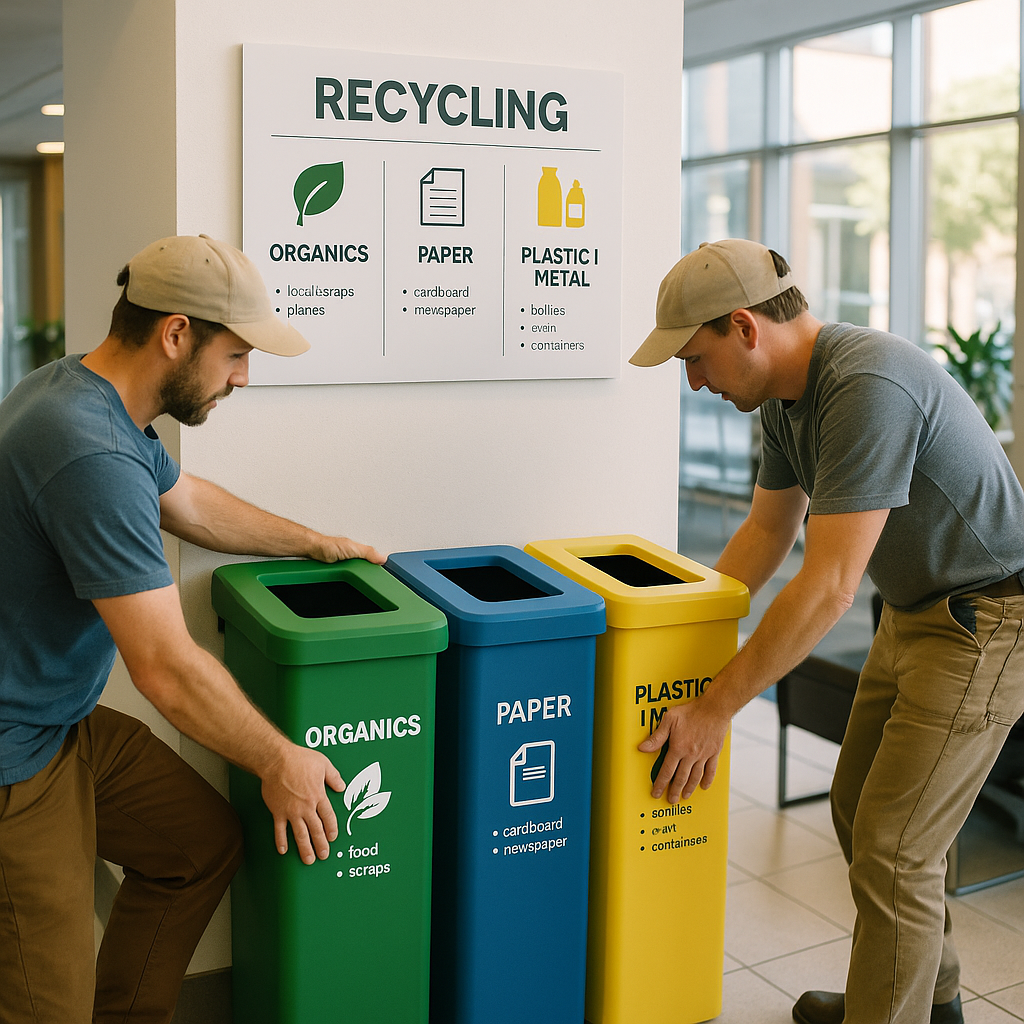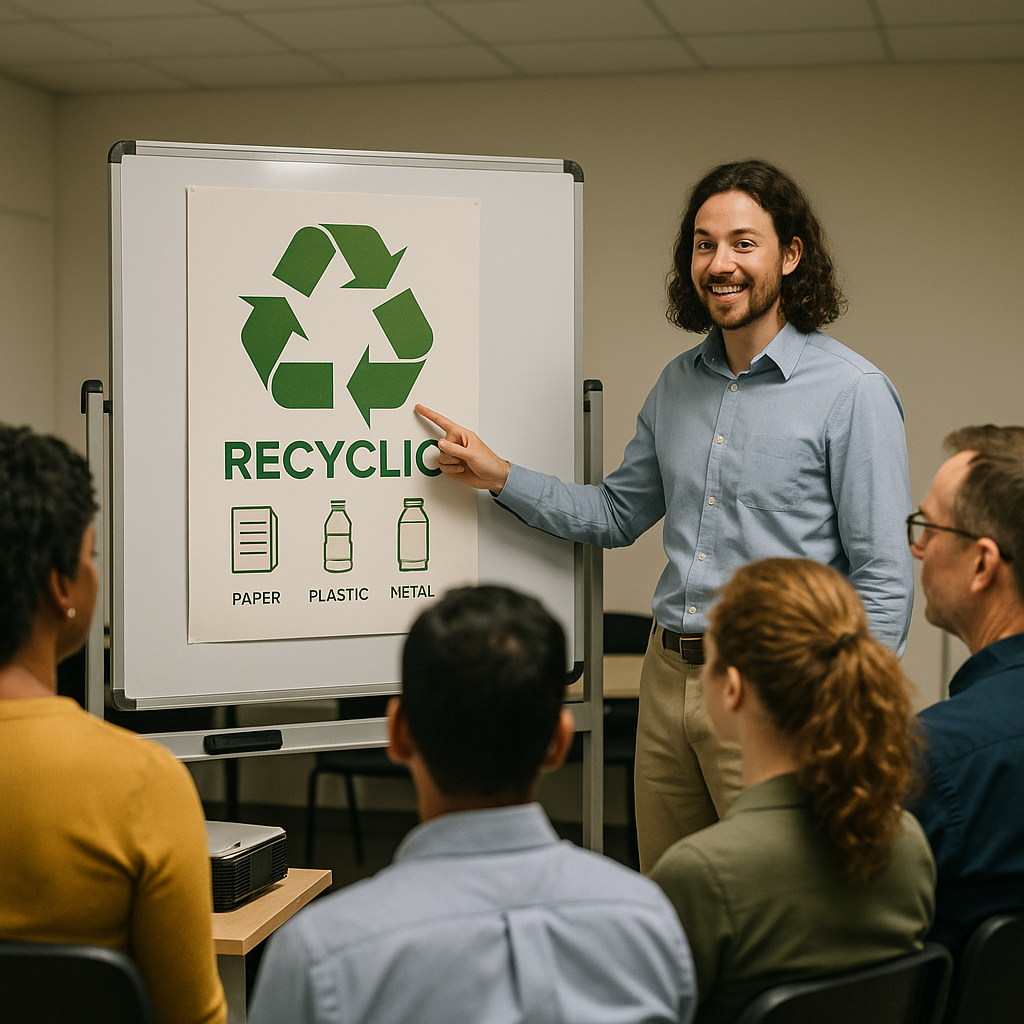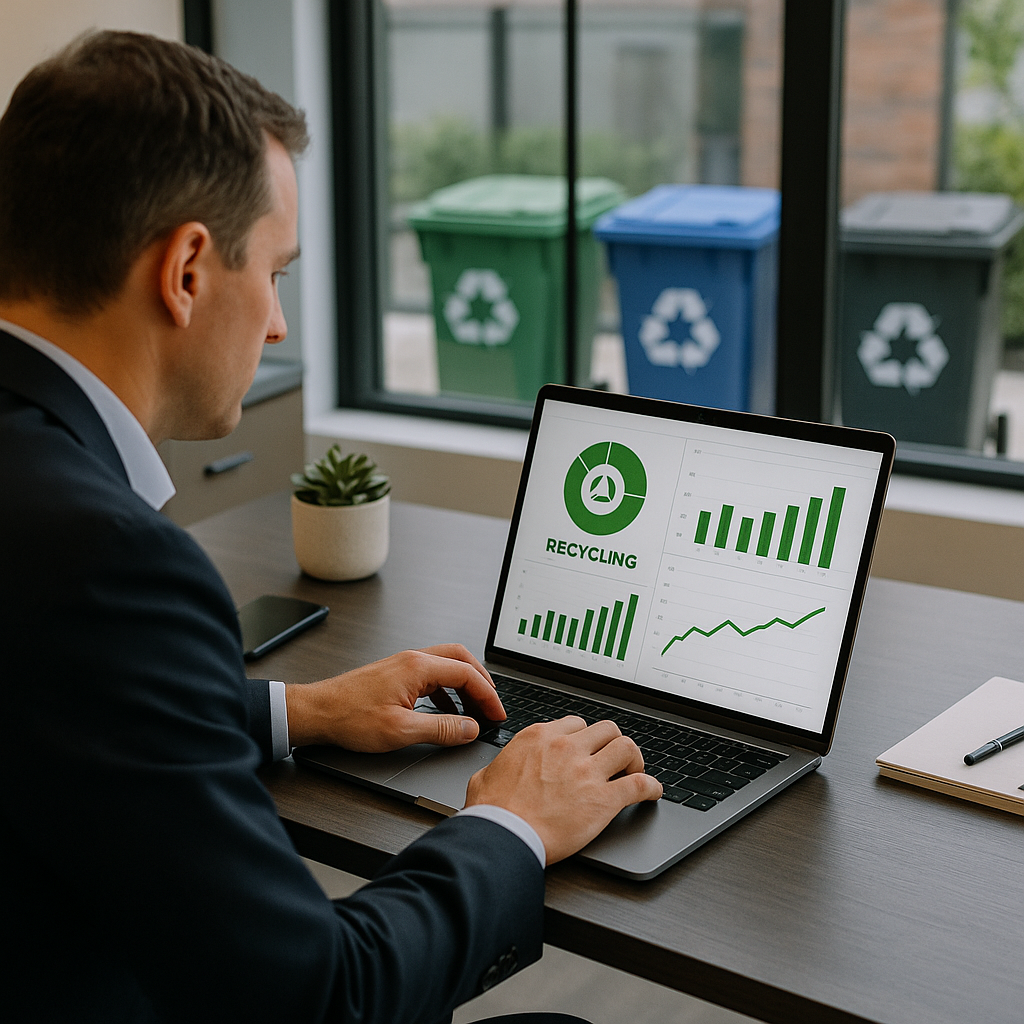5901 Botham Jean Blvd, Dallas, TX 75215
Commercial Recycling Program: A Quick Overview for Businesses
August 15, 2025A commercial recycling program is an organized system for businesses to collect and process recyclable materials. These programs divert valuable resources from landfills and create more sustainable waste management practices. The concept is simple but powerful: businesses separate recyclable items from general waste for proper processing.
Commercial recycling programs vary widely in scale and scope. Some focus on specific materials like paper, cardboard, or aluminum, while others handle multiple waste streams. The right program depends on your business type, waste volume, and local recycling infrastructure.
For businesses of all sizes, implementing a recycling program delivers three core benefits. First, it reduces waste disposal costs by lowering the frequency of trash pickups. Second, it demonstrates environmental responsibility, which resonates with today’s sustainability-conscious consumers. Third, it ensures compliance with increasingly stringent local recycling regulations that many municipalities now enforce.
How Do You Conduct a Waste Audit?
A waste audit is a systematic process that analyzes your business’s waste stream to identify recyclable materials and opportunities for reduction. When properly executed, a waste audit provides valuable insights into waste generation patterns and potential cost savings through improved recycling practices.
Preparation Phase
Before starting your waste audit, gather the necessary supplies. These include heavy-duty gloves, sorting tarps, a digital scale, collection containers for different waste categories, and data recording sheets. Safety should be your priority, so ensure all team members have appropriate protective equipment.
Assemble a diverse audit team with representatives from different departments. This cross-functional approach ensures multiple perspectives and increases buy-in across your organization. The team should understand both the environmental and financial motivations behind the audit.
Data Collection Process
Begin by collecting waste samples from various areas of your facility over a representative time period. For most businesses, a one-week collection period provides adequate data. Ensure you maintain normal operations during this time to get accurate results.
Once collected, sort the waste into clearly defined categories:
- Paper (office paper, cardboard, newspapers)
- Plastics (sorted by resin type if possible)
- Glass
- Metals
- Food waste
- Non-recyclable materials
Weigh each category and calculate its percentage of your total waste stream. Document your findings meticulously, including photographs of sorted materials for reference and training purposes.
Analysis and Implementation
After sorting and weighing, analyze the data to identify patterns and opportunities. Look for recyclable materials currently going to landfill and assess contamination in existing recycling streams. Calculate potential cost savings from diverting recyclables from your general waste.
Use this information to develop an action plan that includes:
- Specific waste reduction targets
- Enhanced recycling collection systems
- Employee education programs
- Partnerships with appropriate recycling facilities
Schedule follow-up audits to measure progress and refine your approach. Most businesses benefit from conducting waste audits annually to track improvements and identify new opportunities.
Key Questions to Ask During Your Waste Audit
- What materials make up the largest percentage of our waste stream?
- Which recyclable materials are we currently sending to landfill?
- Where are our recycling contamination points, and how can we address them?
- What operational changes could reduce waste generation at the source?
- How do our waste management costs break down, and where can we find savings?
- Are there local recycling facilities that accept materials we’re currently landfilling?
- How can we better engage employees in proper waste sorting practices?
- What incentives might encourage better recycling compliance?
The results of your waste audit will serve as the foundation for a comprehensive recycling program. By understanding what’s in your waste stream, you can make informed decisions about collection systems, employee education, and partnerships with recycling facilities.
Many businesses discover through waste audits that up to 70% of their general waste could be recycled or composted, representing significant opportunities for both environmental improvement and cost reduction.
[[artifact_table]] Business Waste Composition by Industry Type [[/artifact_table]]How Do You Set Up Recycling Infrastructure?

Establishing an effective recycling infrastructure requires strategic planning and attention to detail. Start by identifying high-traffic areas throughout your facility where waste is commonly generated. Place recycling stations in these locations to maximize convenience and participation.
When selecting recycling bins, consider both function and visibility. Choose containers that clearly distinguish between waste streams through consistent color-coding: blue for mixed recycling, green for organics, and black for landfill waste. The size of your bins should match the volume of materials typically generated in each area. For example, paper recycling bins should be larger in office areas, while containers for bottles and cans might be more prominent in break rooms.
Strategic bin placement significantly impacts recycling success. Research shows that people typically won’t deviate more than 25 feet from their path to use a waste receptacle, so position bins where they’re naturally needed. Always pair recycling with waste bins to prevent cross-contamination. In office environments, consider removing individual desk trash bins and implementing centralized waste stations that include all necessary streams.
Clear, effective signage is crucial for proper waste separation. Use simple, bold signs with recognizable images of common items alongside text descriptions. Position signage at eye level directly on or above containers. The most effective signs include both what SHOULD and should NOT go in each bin, helping to minimize confusion and contamination.
Shaped bin openings can provide additional visual cues – circular openings for bottles and cans, slot openings for paper. However, ensure these openings are large enough to accommodate all appropriate materials to prevent frustration and improper disposal.
Coordinate with a recycling service provider before finalizing your infrastructure. Understanding their collection requirements will inform your bin selection and placement decisions. Some providers have specific requirements for how materials must be separated or prepared for collection.
For multi-floor facilities, develop a clear waste movement plan. Determine how materials will travel from collection points to central storage areas. Consider using service elevators, designated routes, and appropriate transport containers to move recyclables efficiently without contaminating streams.
Designate adequate storage space for recyclables awaiting collection. This area should be accessible to both staff and collection vehicles, with sufficient room for separate containers for each waste stream. Proper ventilation is important, especially if organic waste is being stored.
Maintain consistency throughout your facility by using the same bin designs, colors, and signage in all areas. This visual uniformity helps reinforce proper recycling behavior regardless of where people are in the building.
Finally, train all staff on proper recycling procedures and the importance of maintaining separation between streams. Regular education and feedback on recycling performance can significantly improve participation and reduce contamination rates over time.
By thoughtfully designing your recycling infrastructure with these elements in mind, you’ll create a system that encourages participation, minimizes contamination, and maximizes the recovery of valuable materials from your waste stream.
How Do You Educate and Engage Employees?

Employee education forms the backbone of any successful workplace recycling program. Even the most well-designed system will fall short without proper employee understanding and buy-in. Training should focus on what materials can be recycled in your specific facility and the correct sorting techniques required by your waste hauler.
Begin by developing clear, accessible training materials that explain your recycling program’s goals and processes. These materials should include specific examples of what can and cannot be recycled at your facility. Remember that recycling rules vary by location, so consult with your waste hauler to ensure your guidelines align with their capabilities.
Utilize multiple communication channels to reinforce your recycling message. Regular staff meetings provide opportunities for direct education and addressing questions. Send periodic email reminders with sorting tips and program updates to keep recycling top of mind. Strategic placement of informative posters near recycling stations helps employees make correct disposal decisions in the moment.
Create Visual Aids for Maximum Impact
Visual communication proves especially effective for recycling education. Develop signage that uses both words and images to illustrate what belongs in each bin. Our brains process visual information differently than text, so combining both elements improves comprehension across your workforce.
Place these visual guides directly above or on recycling bins where decisions are made. Consider using color-coding consistently throughout your facility – blue for paper, green for organics, etc. – to create an intuitive system that employees can quickly understand without reading detailed instructions each time.
Photos of common workplace items being correctly sorted can be particularly helpful. For example, show coffee cups with lids removed and placed in appropriate streams, or demonstrate how to handle food containers with residue.
Appoint Recycling Champions
Identify enthusiastic employees to serve as recycling champions within your organization. These individuals can provide peer-to-peer education, answer questions, and model proper recycling behaviors. When colleagues see respected team members actively participating, they’re more likely to follow suit.
Equip these champions with additional training so they can confidently address common questions and challenges. Schedule regular check-ins with your champions to gather feedback on program implementation and identify areas needing improvement. Their on-the-ground perspective provides valuable insights that management might miss.
Make Education Ongoing and Interactive
Recycling education should never be a one-time event. Schedule regular refresher sessions to address common mistakes and introduce any program changes. Consider conducting waste audits periodically and sharing the results with employees to highlight successes and areas for improvement.
Interactive education methods often prove more engaging than passive instruction. Consider hosting a “sorting challenge” where teams compete to correctly sort a mixed bin of items. Create quick recycling quizzes with small prizes to test knowledge in a fun way. Some organizations have found success with gamification elements like departmental leaderboards showing recycling rates.
Hands-on learning experiences can be particularly effective. Arrange facility tours of your local recycling center so employees can witness firsthand what happens to materials after they leave your building. This creates a stronger connection to the importance of proper sorting.
Celebrate Successes and Share Impact
Regularly communicate the positive impact of your recycling program. Share metrics like pounds diverted from landfill or resources conserved through your efforts. When employees see tangible results from their participation, motivation increases.
Recognize individuals or departments demonstrating exceptional commitment to recycling. This could be through formal recognition programs, mentions in company communications, or small incentives. Creating a sense of collective achievement builds program momentum.
Consider hosting occasional events centered around sustainability. Earth Day celebrations, zero-waste lunches, or recycling-themed contests can reinforce your environmental values while making sustainability fun and social.
Remember that building new habits takes time. Some employees may initially resist changes to familiar waste disposal routines. Patient, consistent education combined with positive reinforcement typically overcomes these challenges. With proper education and engagement strategies, your workplace recycling program can become an integral part of your organizational culture.
How Do You Monitor and Improve Your Program?

Effective recycling programs require constant attention and refinement. Regular monitoring allows you to track progress, identify issues, and implement targeted improvements. The success of your recycling initiative depends on measuring performance through concrete metrics and making data-driven adjustments.
Establishing Key Performance Indicators
Start by determining which metrics matter most for your program. Recycling rates, which measure the percentage of waste diverted from landfills, provide a fundamental baseline. Track contamination levels to understand how well participants follow sorting guidelines. Collection frequency data helps optimize pickup schedules and resource allocation.
Weight measurements offer valuable insights into volume patterns. Many organizations find that monitoring waste generation by department or location reveals unexpected patterns. These metrics establish a foundation for meaningful comparisons over time and help you set realistic improvement goals.
Conducting Waste Audits
Periodic waste audits deliver detailed information about your waste stream composition. During an audit, sample portions of waste are physically sorted and categorized. This hands-on process reveals exactly what materials you’re discarding and in what quantities.
Audits often uncover surprising findings. You might discover certain recyclables consistently ending up in trash bins or high contamination rates in specific areas. Organizations typically conduct audits quarterly or semi-annually, with more frequent evaluations when implementing program changes.
Consider documenting your findings with photographs and detailed notes. This documentation serves as a powerful communication tool when discussing improvements with stakeholders.
Leveraging Data Analytics
Modern recycling programs benefit tremendously from data analytics. Digital tracking systems can monitor fill levels, collection patterns, and participation rates. This technology enables you to spot trends that might otherwise go unnoticed.
Analysis of historical data helps forecast future waste generation and optimize resource allocation. For example, if data shows certain materials consistently spike during specific times of year, you can adjust collection schedules accordingly. Companies using predictive insights have reported increases in recycling rates by 10-15% through better-informed decision making.
GIS (Geographic Information Systems) can add another dimension to your analysis by mapping waste generation patterns across different locations. This spatial data helps identify “hotspots” that need targeted intervention.
Gathering Feedback from Participants
Numbers tell only part of the story. Direct feedback from program participants provides crucial context and identifies barriers to participation. Simple surveys can reveal why people struggle with recycling guidelines or what would motivate greater participation.
Create multiple feedback channels. Digital surveys work well for quick responses, while focus groups allow for deeper discussions. Keep feedback mechanisms simple and accessible to maximize participation. Remember to follow up with participants about how their input led to program changes.
Communities that actively engage stakeholders in this feedback process typically see higher participation rates and stronger program support.
Implementing Continuous Improvement
The most successful recycling programs embrace a continuous improvement mindset. Instead of periodic overhauls, make smaller adjustments based on regular data review. This approach allows for nimble responses to changing conditions.
When data reveals a problem area, develop targeted solutions. For instance, if contamination rates rise in a specific department, focused education efforts might resolve the issue. If certain materials consistently cause confusion, clearer signage may help.
Document all changes and measure their impact. This creates an improvement roadmap that builds institutional knowledge over time. Organizations that follow this approach typically see steady increases in program effectiveness rather than the plateaus that often follow one-time improvements.
Benchmarking Against Best Practices
Compare your program metrics against industry standards and high-performing peers. Industry associations and sustainability networks often publish benchmarking data that provides valuable context for your performance.
Looking beyond your organization helps identify innovative approaches worth testing. Communities that regularly benchmark their recycling programs achieve diversion rates approximately 25% higher than those that operate in isolation.
Remember that meaningful comparisons require similar contexts. A manufacturing facility will have different recycling patterns than an office complex. Look for benchmarking partners with comparable operations and waste streams.
Conclusion: Implementing a Successful Commercial Recycling Program

Implementing a successful commercial recycling program is not just beneficial for the environment, it’s also a smart business decision. Through careful planning, employee involvement, and consistent management, businesses can create recycling systems that significantly reduce waste while often cutting disposal costs. The key steps we’ve explored—conducting waste audits, establishing the right infrastructure, educating staff, and monitoring performance—form the backbone of any effective commercial recycling initiative.
Ready to transform your business’s waste management approach? The benefits extend beyond environmental sustainability to include potential cost savings, improved company image, and compliance with regulations. Start your recycling journey today by contacting Okon Recycling at 214-717-4083 for expert guidance on implementing a tailored recycling program that meets your specific business needs.
